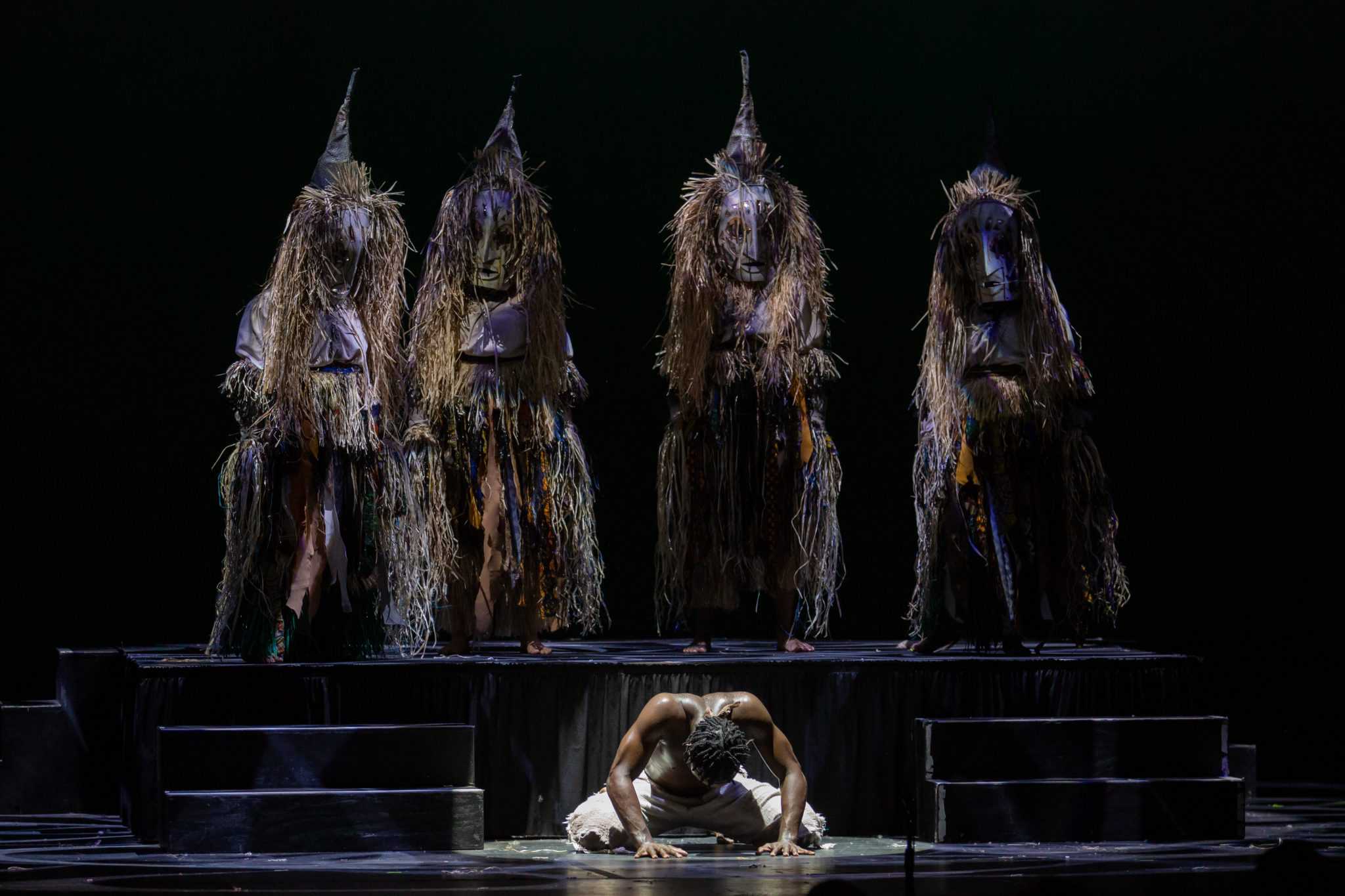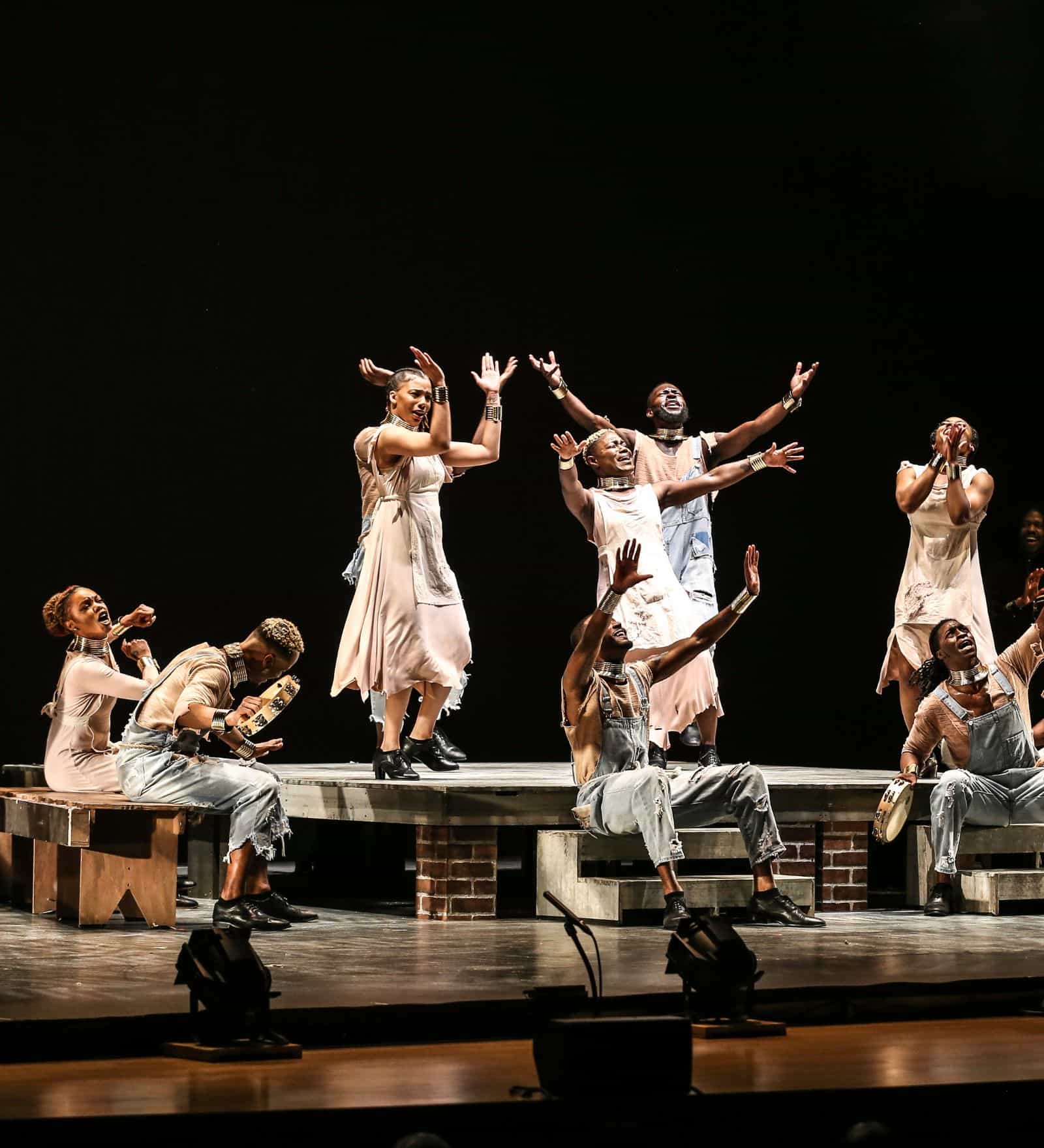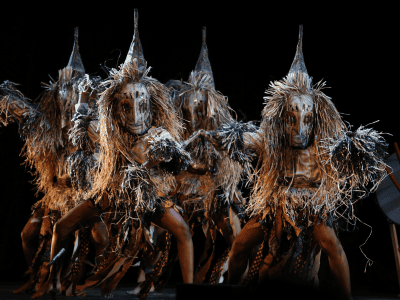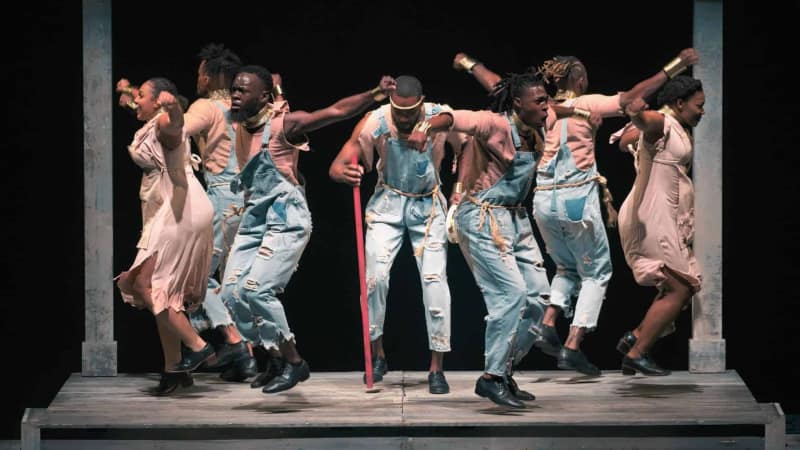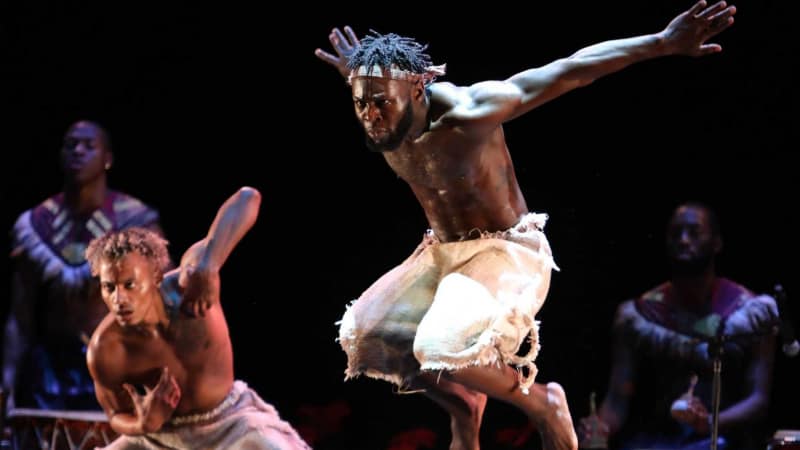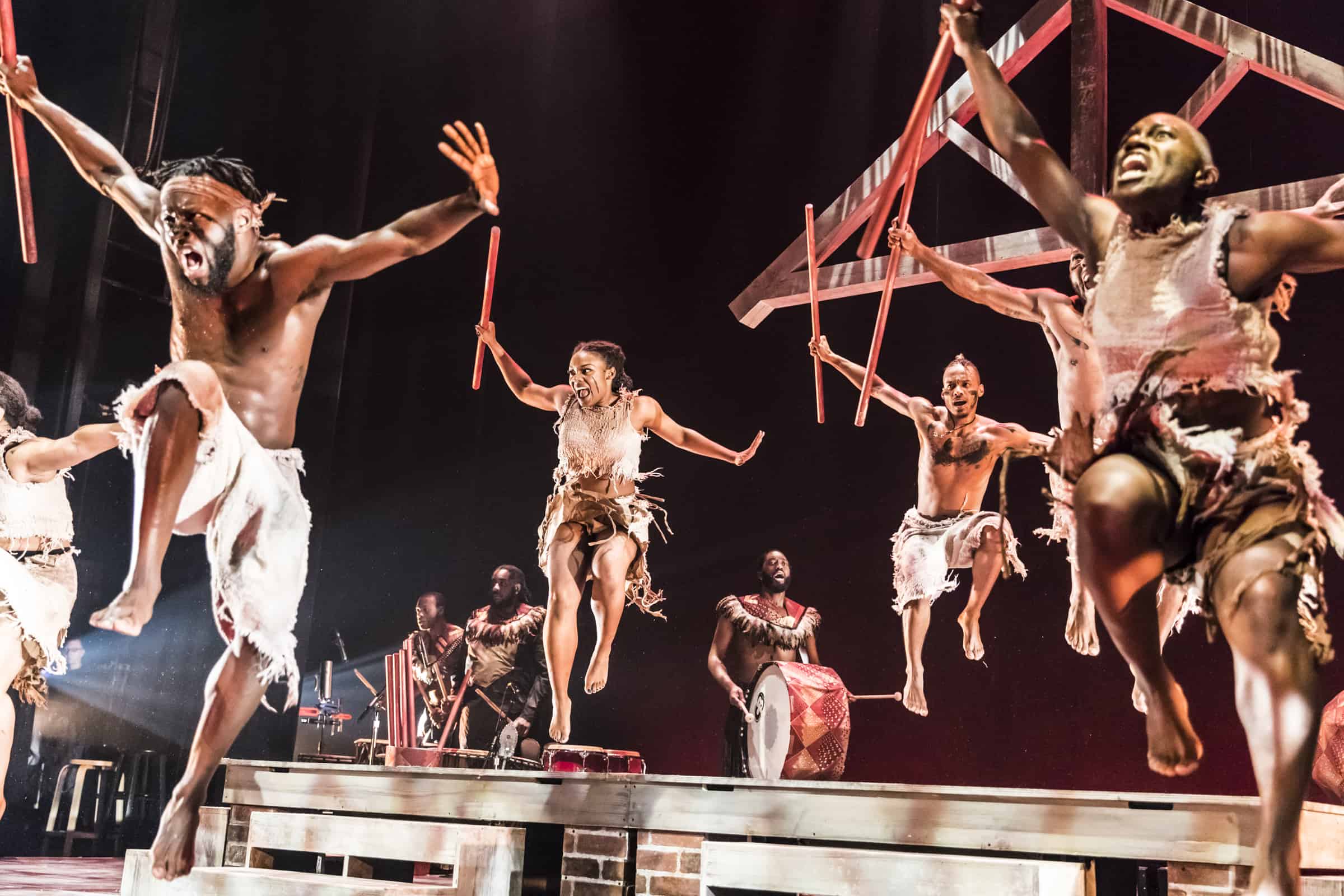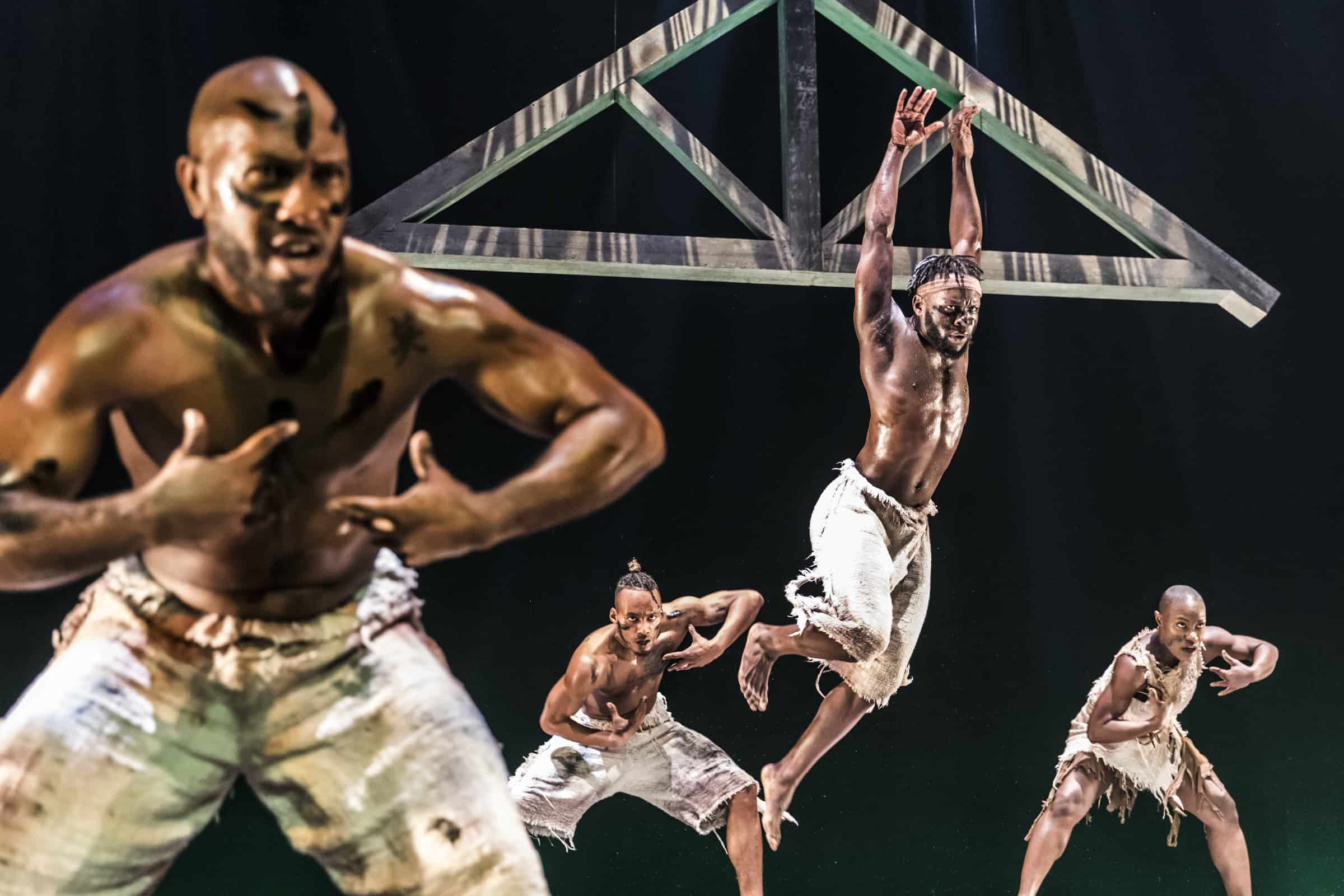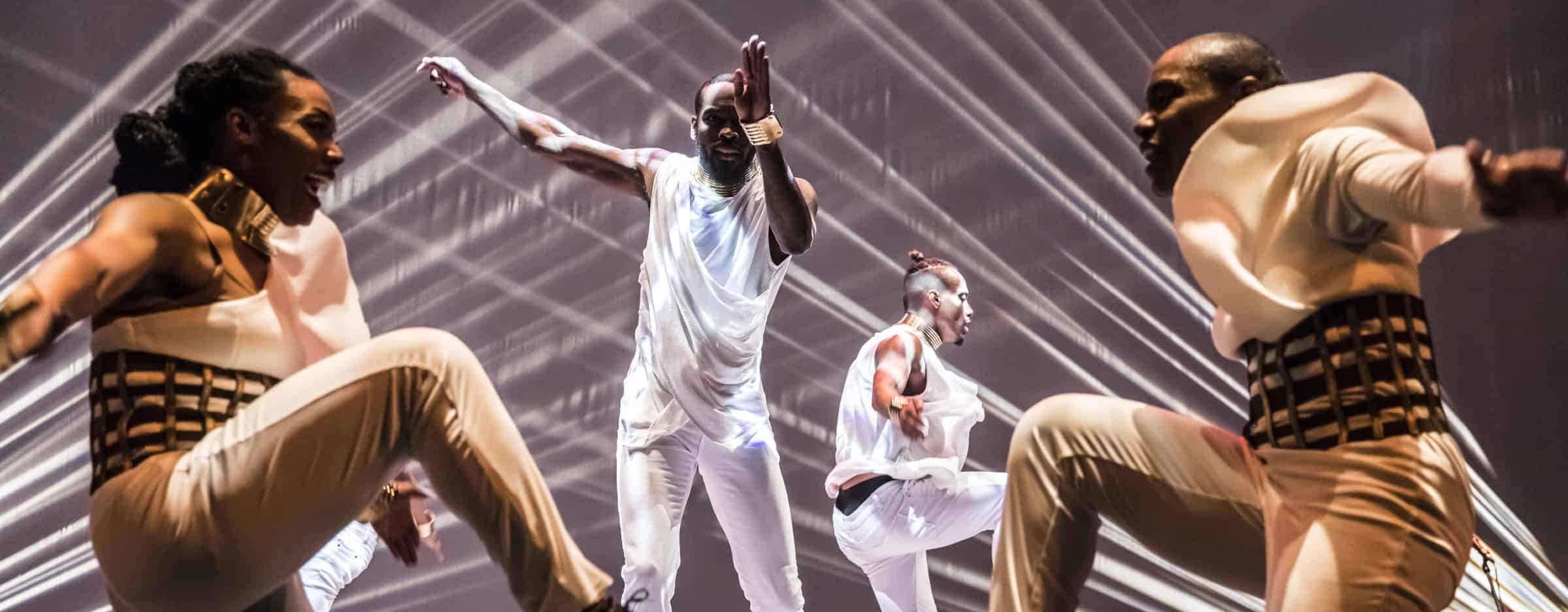Drumfolk
Drumfolk took its final bow November 2023 at the Charleston Gaillard Center in Charleston, SC.
Drumfolk is a rhythmic storytelling of the development of African American percussive dance and movement traditions. Inspired by the Stono Rebellion of 1739, the production explores this little-known event in American history that would forever transform African American life and culture. When Africans lost the right to use their drums, the beats found their way into the body of the people, the Drumfolk. New percussive forms took root leading to the development of some of our country’s most distinct performance traditions like ring shout, tap, and stepping.
Step Afrika! will bring Drumfolk to theaters across the country for a minimum, one-week residency, including feature-length performances, student matinees, master classes and workshops. Looking to learn more ahead of the show? Our educational guide is designed to help you enjoy Step Afrika!’s performance of Drumfolk. You will find information on the history of the Drumfolk, the development of percussion in African American culture, and the exploration of Resistance, Resilience, and Reclamation.
Note: Step Afrika! uses the phrase “enslaved Africans” to honor the life and legacy of those who endured the era of slavery. This term restores their humanity, acknowledges their experience, and affirms their cultural impact on American history.
Meet the Drumfolk
Join C. Brian Williams, Mfoniso Akpan, and the company as they explore the history behind Step Afrika!’s work, Drumfolk.
THEY TOOK THE DRUMS AWAY…BUT THEY COULD NOT STOP THE BEAT
Drumfolk is made possible by the New England Foundation for the Arts’ National Dance Project with lead funding from the Doris Duke Charitable Foundation and The Andrew W. Mellon Foundation.
Lead Commissioning Support is provided by Arts Emerson, Hancher Auditorium at the University of Iowa, Strathmore, and the Eugene M. Lang Foundation.
Additional support is provided by the Krannert Center for the Performing Arts at Illinois, The New Victory Theatre, Delaware Art Museum, Meany Hall for the Performing Arts at University of Washington, Younes and Soraya Nazarian Center for the Performing Arts, and the DC Commission on the Arts and Humanities.
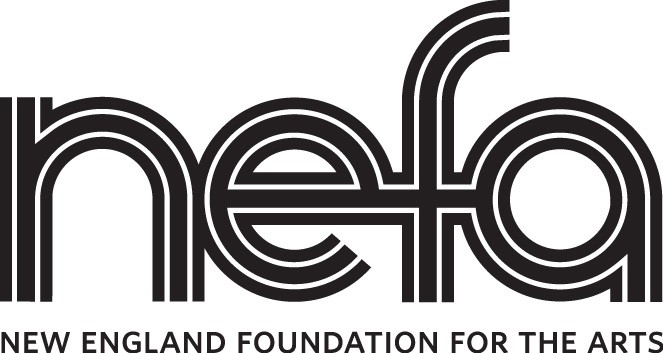
Welcome to Step Afrika!’s Educational Guide for Drumfolk!
This educational guide is designed to help you enjoy Step Afrika!’s performance of Drumfolk. You will find information on the history of the Drumfolk, the development of percussion in African American culture, and the exploration of Resistance, Resilience, and Reclamation.
The History of the Drumfolk
The Importance of the Drum
The drum is a type of percussive instrument and central to telling the story of African dance, music, and culture. Drums are the world’s oldest and most ubiquitous musical instruments, and the basic design has remained virtually unchanged for thousands of years. As a crucial element in many cultures, the drum is used to celebrate significant events, entertain listeners, mobilize community, and to communicate across long distances.
When Africans were first arrived in America, they brought their traditions and culture with them. Since enslaved Africans came from all over the continent and spoke many different languages, the drum became a universal way to communicate across cultures. When slaveholders recognized the power of the drum, they drafted the Negro Act of 1740, making it illegal for Africans to use the drum to communicate or celebrate.
The Carolinas and the Gullah People
The Gullah Geechee people are descendants of Africans who were enslaved on the rice, indigo plant, and cotton plantations on the lower Atlantic coast in the late 1500’s. The original Africans were taken from different tribes and regions that also spoke different languages. Forced to adjust in their new life, the enslaved people created a new culture based on the intermingling of their various languages and customs. Ultimately, this was the beginning of the Gullah people.
One of the largest importations of Africans to the Carolina area occurred in the early 1700’s. More Africans from the country of Angola were brought to the Lowcountry region of South Carolina than any other African country, totaling about 40% of the enslaved population. Angola is located in southwestern Africa, along the Atlantic coast. Angola is bordered by the Democratic Republic of the Congo, Zambia to the east, and Namibia.
The Africans developed survival and resistance strategies, as well as cultural and spiritual practices that were necessary to endure the Carolina environment. Even after the abolishment of slavery, the deeply rooted African traditions continued to shape the culture of the Gullah people. The Gullah people developed their culture not only from their distinct African roots, but also because of their isolation from white people.
Bessie Jones
Mary Elizabeth “Bessie” Jones (February 8, 1902 – July 17, 1984) was an American gospel and folk singer who taught traditional songs, games and stories to young people and their families in rural Southern America. Bessie Jones is responsible for creating the term “drumfolk”, which referred to people who practiced the song, movement, and percussive traditions of the Gullah-Geechee culture. These musical traditions addressed how people experienced elements of life, work, play, and praise, and passed down traditional African-derived dance movement and rhythmic styles.
The Stono Rebellion
The Stono Rebellion was the most serious and deadly revolt by enslaved Africans in colonial United States.
In 1739, a group of enslaved Africans were part of a work gang building a public road in South Carolina. The road gang was poorly guarded, and twenty men took this opportunity to rise up against the mistreatment and backbreaking slave labor.
Led by an Angolan named Jemmy, the men gathered at the Stono River bridge. They walked to the nearby Hutchinson’s store, where they stole guns and gunpowder and killed two white workers. They continued to the Edisto River, killing more than 20 whites and acquiring more firearms and gunpowder. Using their drum as a call to action, the gathering Africans shouted “Liberty” as they incited a rebellion. By the time the Africans reached the river, their number had grown to around 100 people.
Lt. Gov. William Bull witnessed the gathering, sounded the alarm to local whites, and led a posse of well-armed men to face Jemmy’s group at the Edisto River. Jemmy and his followers were out-numbered by Bull and his posse. Within a few hours, 30 of Jemmy’s group were dead, while the rest escaped into the woods. During the following month, most of those who made their escape were captured and killed.
The Negro Act of 1740
Following the Stono Rebellion, South Carolina authorities initiated the Negro Act of 1740. The Negro Act prohibited enslaved Africans from growing their own food, earning money, and learning to read. It also prevented them from gathering and using drums, horns, or other loud instruments. The provisions of the Negro Act, including the ban on drums, quickly spread across the United States.
They Could Not Stop the Beat
After drums were banned, enslaved Africans found other ways to communicate and celebrate. They used everyday objects such as spoons, washboards, and furniture to create rhythms. They also began to use their bodies as percussive instruments; techniques such as hand clapping, pattin’ juba, foot stomping and tapping, and shuffling (Ring Shout) were created to reproduce the complex rhythms of African drumming.
The most widely used substitute for drums was the human voice. Field hollers, call and response, work songs, prison songs, and various kinds of vocality were developed to replicate drum patterns. These vocal elements filled the incremental spaces between a hand clap or foot stomp; therefore, playing an important role in the preservation of African rhythmic heritage.
SOURCES FOR THIS SECTION
Niven, Steven J. The Stono Slave Rebellion Was Nearly Erased From US History Books. The Root website. https://www.theroot.com/the-stono-slave-rebellion-was-nearly-erased-from-us-his-1790854336. February 22, 2016.
Rhapsodyinbooks. May 10, 1740 – South Carolina Enacts the Negro Act of 1740. Legal Legacy website. https://legallegacy.wordpress.com/2015/05/10/may-10-1740-south-carolina-enacts-the-negro-act-of-1740/. May 10, 2015.
The Beat Goes On…
After the banning of the drum, the “drumfolk” culture continued to develop and transform with the current times. Here are some art forms that were created with the influence, spirit, and embodiment of the drum.
Ring Shout
A shout or ring shout is a religious ritual, first practiced by enslaved Africans in the south. Worshipers move in a circle while shuffling, stomping their feet, and clapping their hands. Despite the name, shouting out loud is not an essential part of the dance. During slavery, many shouted to cope with their harsh reality. Despite the circumstances, ring shouts were often joyful celebrations. One person typically starts the shout by leading a song that incorporates call-and-response. Oftentimes, another person maintains the rhythm and tempo by beating a broomstick or piece of wood on the floor.
Patting Juba
Pattin’ juba is a traditional dance that enslaved Africans brought to the United States. The dance starts with a clapping or slapping of the arms, chest, cheeks, knees, and legs; creating a rhythmic pattern. Oftentimes enslaved people would participate in an impromptu gathering with no instruments and had to pat their bodies and tap their feet to create their own rhythms.
Hambone
Hambone is rooted in African and African American culture and uses the entire body as a drum to produce different sounds. Hambone can be practiced as group or individually. The actual word “Hambone and the art form is considered as a symbolic way to honor the cultural memory, creativity, and daily life of African Americans in enslaved communities.
Buck, Wing & Jig Dancing
All three social dances originated among African Americans during slavery. The art forms are improvisational and spontaneous, as the dancer is free to create their own rhythmic interpretation and music using their bodies.
- Buck is a percussive art form where the movements are weighted, keeping the knees low and the feet fully on the floor. Buck dancing is also credited with being the beginning of tap dance.
- Wing refers to a dancer flapping their arms and legs, exhibiting bird-like movements.
- Jig uses lots of energy and velocity. This dance form is much lighter in movement, requiring the dancer to jump and skip.
Some combination of all three of these dances led to the creation of popular movements that are known today, such as Footwork, The Charleston, Kid ‘n play, and the Butterfly.
African American Spiritual
Spirituals are songs that were created by African Americans in the United States. This communal and oral tradition imparted Christian values while also describing the hardships of slavery
Religious services were the only place enslaved people could legitimately congregate, socialize, and freely express their feelings. During these meetings, worshipers would sing, chant, dance, and shout. Incorporating the long-standing African tradition of storytelling, spiritual and gospel music was an essential element in communicating identity and sharing social values, traditional customs, and ethnic history.
Tap
Tap is a style of dance that requires shoes with metal attached to the bottom, that creates sounds against the hard floor. Tap dancers create these rhythms using signature movements such as chugging, scooping, brushing, and shuffling. Initially a fusion of West African and American traditions, tap emerged as dance form that emphasizes polyrhythms, recurring patterns, and structured improvisation.
Beatboxing
Beatboxing is an innovative art form that only uses the mouth, throat, and nose to create various sounds. It is also known as “vocal percussion,” since the mouth is used to imitate the percussive sound of the drum. The term “beat box” was first used as slang for electronic rhythm machines called synthesizers. In the 1980s, many Hip-Hop MCs could not afford the expensive equipment and discovered a new, more accessible instrument; the mouth. Thus, human beatboxing was born.
Rap
Rap is a musical and vocal form that incorporates rhyming and rhythmic speech, cadence, and tone. Rapping can be connected to the African Griot tradition, in which similar techniques were used to pass down cultural stories. Rap is also often performed to an instrumental song with a constant beat, typically provided by a DJ or beatboxer. Many rap songs noticeably prioritize replicating the sound of the drum.
The Beat Continues
Stepping
Step Afrika! is the first professional company in the world dedicated to the tradition and cultural heritage of stepping.
Stepping is a percussive art form first developed through the song and dance rituals performed by African-American fraternities and sororities. In stepping, the body becomes an instrument, using footsteps, claps and spoken word to produce complex polyrhythms. Stepping has been described as “one of the most exciting dance forms created in the 21st century.”
In the early 1900s, African-Americans began to attend American colleges and universities in greater numbers, and the students recognized a need to develop Greek-letter organizations that would support them both academically and socially. Stepping became a way that members of these student groups (known today as the Divine Nine) expressed love and pride for their organizations.
Stepping is an evolving art form that has absorbed many cultural influences including military drilling, black social dances, children’s games, cheerleading, martial arts, music bands, acrobatics, and tap dancing. The art form’s use of synchronized movement, words (often in call-and response form), and polyrhythm (several different rhythms used at the same time) communicate allegiance to a group and bears striking resemblance to movement practices found across the African continent.
Although stepping is historically associated with college groups, today the art form is universal, and practiced in schools, dance classes and churches across the country. Stepping has been featured in motion pictures such as Stomp The Yard, School Daze and Drumline.
Because most of the signature movements of stepping are based on traditional western and central African dance styles, many assume it originated in Africa. Although created in the United States, stepping is a unique African American dance form that is “animated by the style, spirit, social, and aesthetic organization of sub-Saharan Africa” (Rodger Abrahams). Traditional African celebrations include the use of song, dance, music, and language. Stepping continues these practices and they are central to the success of a stepping performance. The five traits of western African dance and music are also noticed when watching stepping:
- a dominant percussive concept
- multiple meter or patterns
- call and response
- song and dance that acknowledge or mock observers
- a separation of playing and dancing.
SOURCE
Malone, Jacqui. (1996). Steppin On The Blues. Urbana, IL. The Board of Trustees of the University of Illinois
Resistance, Resilience, and Reclamation
Resistance is the courage and determination used to stand against an injustice.
Since the beginning of slavery in the 1500s, Africans and African Americans resisted against the harsh imprisonment. Many forms of resistance were performed, the most common included revolts, suicides, burning plantation property, and escaping to free states or communities. The goal of rebellion was total liberation from slavery; most forms of resistance were more subtle and an attempt to make life a bit more bearable. Daily acts of resistance included slowing the work pace, pretending to be sick, sabotaging crops, and injuring plantation animals. Sometimes enslaved people stole essentials such as food and clothing to give to their families while also taking property and potential profit away from the slaveholder. Some of the enslaved learned as many trades as possible, to decrease their chances of being sold. Others developed families as a form of resistance, by getting married and having children.
Many enslaved Africans maintained their cultural traditions to resist against slavery, including their music and spirituality. Music served a literal function to help the workday go faster and included messages that offered instructions or a call to action. For example, there were songs that provided information about the Underground Railroad and Harriet Tubman. Music was also a way to express feelings of sorrow, joy, inspiration, and hope. Songs were passed down through generations, and this cultural pastime remained prominent in the African American community.
Keeping their cultural traditions alive offered enslaved Africans and African Americans a common sense of identity, community, and encouragement. Enslavers recognized the power of gathering and attempted to control this occurrence. Drums were banned, as well as the ability to gather in groups; an effort to stop potential resistance against enslavement.
Throughout American history, African Americans have continued to fight for justice. Acts of resistance have shifted with the era, as racism continued from slavery to segregation and inequality, racial profiling, mass incarceration, and police violence. Nonviolent tactics such as sit-ins, boycotts, and strikes were performed during the Civil Rights Era. Today, a new wave of resistance has been ushered in by efforts such as kneeling during the national anthem, “Black Lives Matter” and “Buy Black” movements and
Resilience is overcoming life’s challenges using emotional, social, or spiritual strength.
Upon the initiation of the Negro Act of 1740, enslaved Africans were prohibited from growing their own food, assembling in groups, earning money, or learning to read. Though some of the restrictions were already established, the Negro Act ensured they were strictly enforced. Being stripped of so many human and civil rights could be devastating, but Africans survived, adapted to their circumstances, and continued to progress and establish a quality of life.
Many forms of resistance utilized by Africans and African Americans also confirmed their resilience. Faith, family, music, and arts their spirits, created community, and empowered them to be resourceful and creative. Enslaved Africans used the skills and knowledge from their homeland to adapt to their current environment, and many of these traits and traditions are still recognizable in African American culture today. Building fish nets, weaving baskets, creating textiles, and growing produce are examples of skills that Africans brought to this country that African Americans have adapted to the changing circumstances.
Reclamation is the process of restoring and recreating culture and identity.
African Americans have had a long history in the United States, from slavery to today. In the midst of their resistance and resilience, Black people are also striving to restore and maintain their rights, dignity, and identity. Reclamation has been a goal since the first Africans were brought to America in the 1500s.
African American culture is largely rooted in West and Central Africa, considering most enslaved Africans originated from those areas. Africans were considered to be uncivilized despite having their own fashion, music, religions, and languages. These cultures were intended to be stripped from Africans through the institution of slavery, but aspects of those cultures were maintained. As the United States developed, African Americans were forced into a new lifestyle, while still incorporating many aspects of African culture. As the modern environment evolved, Blacks merged their American practices with their African traditions, and a new culture was born.
There are many examples of the reclamation and reintegration of African American culture. Throughout time, Blacks have redefined and reshaped aspects of their culture such as music, language, identity, and style.
- Reclaiming music: The improvisational element of Black art and music developed as a result of the constant disruption to the establishing environment. This is especially prominent in Jazz and Blues, expressive genres that reflected the struggles of the living in the Mississippi Delta. Self-expression about the Black experience in America continued during the Harlem Renaissance era and the Black Power Movement. Hip-Hop is the most recent example of reclamation, which developed during the late 1980s, when Blacks used old records to create new sounds.
- Reclaiming language: Language popular in Black culture has been called African American Vernacular English or “Ebonics”, merging the words “ebony” and “phonics”. This dynamic, distinctive variety is deeply intertwined with African American history, literature, education, and social life. The vernacular has its own words, rules, and traditions that have been around for generations and are only known in the Black community. Some scholars who study the African American Vernacular believe that enslaved Africans learned this variety of language by interacting with English indentured servants and other poor workers. Others emphasize it African origins, noting that West African languages have similar rules and traditions. Most scholars believe today’s vernacular is derived from the Creole languages enslaved Africans created to communicate with each other and their enslavers.
- Reclaiming identity: Black naming practices are also a form of resistance and reclamation. Recognizing last names belonged to their ancestor’s enslavers, Black people insistently give their children unique names; an attempt to reclaim identity.
- Reclaiming style: The style of dress associated with Black culture incorporates elements of African style. Vibrant colors, large jewelry, and head scarves are examples noticed today that Africans’ also wore for self-expression.
